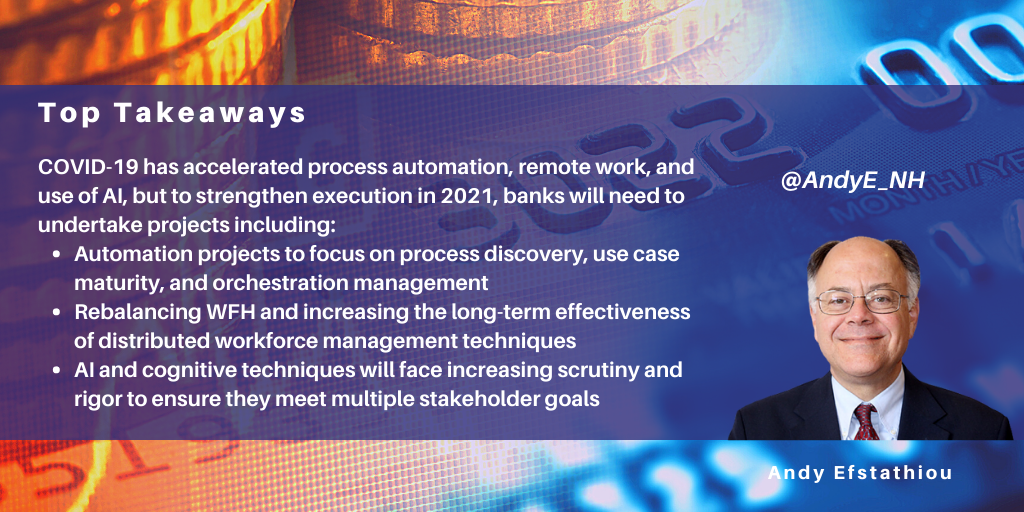posted on Dec 18, 2020 by Andy Efstathiou

Banks will spend 2021 pursuing different aspects of three key initiatives that have become more important since the advent of COVID-19. The first is process automation, which has become more important but needs to increase its delivery effectiveness. The second, work-from-home (WFH) has also accelerated under COVID-19 but will need to change in 2021 to continue to be effective. The third is the application of cognitive to processing. Cognitive is an immature technology and has had teething pains with bias and ethics. Users of cognitive technologies will need to include controls to meet ethics requirements that society requires of its business community.
Process Automation
Process automation has been an accelerating trend for the past four years. Since COVID-19 struck earlier this year, the adoption rate of automation has pulled three years of anticipated adoption work into the second half of 2020. However, this acceleration has highlighted key challenges to effectiveness. They are:
- Process discovery: the acceleration in the pace of adoption has highlighted that banks do not fully understand the processes and process bottlenecks that need automation. Multiple vendors have been developing enhanced process discovery tools to increase the speed at which banks can identify processes
- Use case yield: most banks have been toying with many POCs to try to improve process effectiveness. However, the majority of cases (sometimes as high as 90%) fail to meet their required rate of return to justify their deployment. Third-party vendors are well-positioned to improve the yield on POCs due to their work with multiple clients in many industries. Increased rigor of use case development, based on experiences to date, will enable higher throughput from conception to operations
- Orchestration: once the bots are deployed, especially in a highly distributed environment such as cloud or multi-country, effectiveness declines rapidly. Orchestration tools are being built and improved to improve effectiveness.
These issues have become a priority for banks. Our conversations with bank executives indicate their highest priorities for RPA engagements are:
- Increasing the yield to operational deployment from POCs and use cases
- Maintaining the effectiveness of bot deployments while adapting the operational environment to changing business conditions.
In 2021, they will focus their automation initiatives on compliance (especially the conversion of loan contracts to a post-LIBOR world), customer service, improving agent effectiveness, and KYC/AML reviews.
Work from Home
The COVID-19 world has seen a mass migration to WFH. However, CEOs and other leaders are concerned about workforce morale and training issues over the long term. Bankers we have spoken to expect WFH will remain a larger part of the financial services environment, but much smaller than it is today. Specifically, interviews we have conducted indicate banks expect 70% of workers to move back to offices and ~30% to remain in a WFH environment. Over the next year, institutions will have to work out what the shape of the new workforce deployment will be. Key issues will include:
- Which workers will be on-premise and which in a WFH environment?
- What are the criteria for working in each environment?
- What are the conditions and frequency of being on-campus or off-campus?
- How will this impact the shape of teams?
- What automation and security will be required to support workers over the long term in this new environment?
Until the lockdowns end there will not be much movement on this issue. However, the second half of the year should see the economy open up and these issues will take center stage.
Cognitive Processing Support
Banks and technology vendors have been developing and trialing cognitive support tools for many years now. The aggressive move to digital channel environments caused by COVID-19 has both enabled the application of cognitive tools to business processes and necessitated the use of cognitive tools to deliver services. However, accelerated deployment of cognitive tools has highlighted challenges including:
- Bias: ML and AI tools are inherently backward-looking. Improving society or reducing inequities will not happen from a backward-looking analysis. The algorithms, use cases, and human oversight of these tools will be overhauled in the upcoming year
- Compliance: to date, the primary use of cognitive has been within an individual market and silo at a bank. Moving into 2021, banks are looking to deploy cognitive across silos and markets. Understanding data from across heterogeneous environments is a big challenge, but regulators are requiring banks to deliver on this.
The above growth areas of technology services for banks in 2021 are the result of 2020’s rapid deployment of immature technologies. Each of the three growth segments of services will, as usage matures, provide banks with increased agility to adapt to a rapidly changing business environment.
